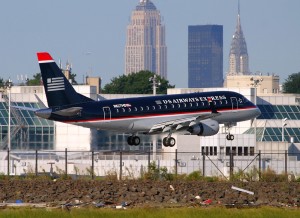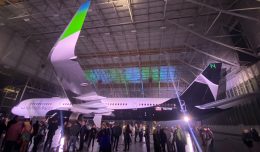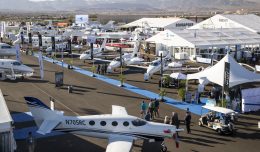The US Airways terminal at LaGuardia Airport can be eerily quiet these days. At one time home to the largest airline operation at the airport, the once bustling corridors are now dominated by US Airways Express flights to regional destinations operated, by and large, by some of the smallest commercial aircraft serving the airport.

US Airways Airbus A320 taxiing after landing at LGA. (Photo by Matthew Smith)
Those corridors won’t be quiet for long. The US Department of Transportation (DOT) has tentatively approved a deal where US will transfer 132 slot pairs at LaGuardia to Delta Air Lines in exchange for 42 slot pairs at Washington Reagan National Airport, the rights to operate a daily flight to Sao Paulo, Brazil beginning in 2015 and $66.5 million in cash. Delta will in turn take over part of the airline’s terminal (also known as Terminal C or the East End Terminal) at the New York airport and connect it with its adjacent Terminal D. Once the deal closes—the LaGuardia portion of which the US Department of Justice approved on October 11—US will be left with just its Shuttle service to Boston and National as well as flights to Charlotte, Philadelphia and Pittsburgh.
US Airways has, for all intents and purposes, given up on LaGuardia.
The airline has been downsizing its operations at LaGuardia since September 11, 2001. US announced 23% across the board capacity cuts in the weeks immediately following the attacks and slowly converted its large mainline operation at the airport to one dominated by its Express operation, which has been flown by a mix of 31-seat Saab 340s, 37-seat Bombardier Dash-8s and 50- or 70-seat regional jets, during the intervening decade. As an example of how much capacity has been cut, in a recent DOT filing, US reported that aircraft with 37 seats or fewer operate 39% of its flights from the airport. Today, its LaGuardia focus city is, in reality, an Express focus city with a few mainline flights to hubs.
Numbers back up these cuts. US’s operations at La Guardia shrank to 4.34 million in 2010 from 6.58 million passengers in 2000, a 34% drop, according to Port Authority of New York and New Jersey (PANYNJ) statistics. American Airlines’ and Delta’s passenger numbers rose 23.6% to 4.98 million and 14.4% to 7.02 million, respectively, during the same period. It should be noted that American’s operations at LaGuardia peaked at 6.24 million passengers in 2006 before falling to their 2010 totals. US was the largest carrier at the airport in 2000, carrying 26% of total passenger traffic. By 2010, it had fallen to third after Delta (29%) and American (21%).
The irony of the carrier’s downsizing at LaGuardia is that the airport is arguably the most sought after domestic destination for airlines in the US. American Airlines and Delta have both publicly stated the strategic importance of their operations at the airport (and in New York), putting their money where their mouth is by acquiring additional slots and investing in terminal facilities trying to outmaneuver the other. Southwest Airlines bought the bankrupt ATA for $7.5 million in 2008 just for the 14 LaGuardia slots its carcass contained in order to begin service to the airport. So why is US giving up on LaGuardia while others continue to grow?
“It is a version of the circle your wagons around your strategic hubs strategy,” says Robert W. Mann, an airline industry analyst at RW Mann & Company, on US Airways decision to significantly downsize its operations at La Guardia. He explains that the only destinations that an airline can strategically defend well are hubs in today’s market. These for US are Charlotte, Philadelphia, Phoenix and its focus city at Reagan National.

Smaller Embraer Jets, such as this E-170, are known to take over some operations previously flown by larger aircraft types into La Guardia. (Photo by Phil Derner, Jr.)
The airline called its LaGuardia operation “unprofitable flying” and its terminal “expensive facilities” in its filing with the DOT for the slot swap with Delta. A spokesperson for US declined a request for an interview for this article. Other contributing factors to the decision to downsize at LaGuardia include declining passenger traffic on short routes, new competition and a reluctance by US management to invest in a new fleet for its wholly-owned Express subsidiaries.
The number of enplaned passengers on flights less than 500 miles dropped 8.5% nationally between 2000 and 2010, according to Bureau of Transportation Statistics numbers. This shift was even starker at LaGuardia where that number fell 16.9% during the same period. US was disproportionately affected by this trend as the majority of its flights from the airport were (and are) on routes like these in the northeast and mid-Atlantic. For example, New York to Charlotte—one of its longer routes from the airport—is only 533 miles. In addition, it lacks the strong connecting operation that it has at its other hubs and focus cities.
The New York airline market has become much more competitive during the past decade. In 2000, JetBlue Airways was just a new upstart at John F Kennedy International Airport, Southwest Airlines and Spirit Airlines only served Long Island MacArthur Airport 45 miles to the east and AirTran Airways had a nominal presence at LaGuardia. Today, JetBlue is a major force to be reckoned in the New York area, Southwest has its 14 slots and Spirit and AirTran have both become notable low-cost competitors on north-south routes along the east coast out of La Guardia. This is not to mention the increased competition from American and Delta. US has faced and dealt with competitive challenges, from both low-cost and other legacy carriers, well elsewhere but, it would appear, was simply not up to the challenge in New York.
Finally, US continues to put off a decision on the future of fleet of its wholly-owned Express carrier Piedmont Airlines. The commuter airline operates the majority of those 39% of flights at LaGuardia on aircraft with fewer than 37 seats on aged Dash-8s that, according to numerous industry analysts, need to be either replaced or retired during the next few years. It currently flies 30 -100s and 11 larger -300s with an average age of 21.4 years, according to Airfleets.net. Many suspect that management’s inaction on this issue is a signal that it plans to eventually retire the Piedmont fleet without a replacement—a move that effectively seals the fate for the bulk of US’ operations at La Guardia if it were to keep its slots.
It should be noted that replacing the Piedmont fleet has been somewhat out of the control of US management. Bombardier stopped manufacturing the -100 in 2005 and the -300 in 2009, leaving only the 78-seat Q400 on the market. A Piedmont employee says that the airline has faced difficulty acquiring any replacement Dash aircraft for a “reasonable” price on the secondary market due to high demand. The ATR-42-600 is the only comparable aircraft to the existing fleet that is still in production; however, the type is rarely seen in commercial operations in the US due to prior issues involving wing icing.

These and other factors have certainly driven the decision by US to agree to swap its slots at LaGuardia with Delta. But any way you look at it, the deal ends an era for the airline. One that was the result of its mergers in the 1970s and 1980s – with Mohawk Airlines in 1972, Empire Airlines (by way of Piedmont Airlines) in 1985 and Piedmont itself in 1989. The capstone came in 1992 when Continental Airlines agreed to sell 62 jet slot pairs and 46 commuter pairs at LaGuardia from the assets of bankrupt Eastern Air Lines for $61 million to US. That purchase provided it with the lease to the then under construction East End Terminal, allowing it to consolidate all of its operations under one roof and fill those corridors with the bustle and energy of a mini hub.
The slot swap deal is a sad end of to the largest operation by a single airline at the nation’s most sought after airport for more than a decade—an enviable position for many. Goodbye US Airways.







